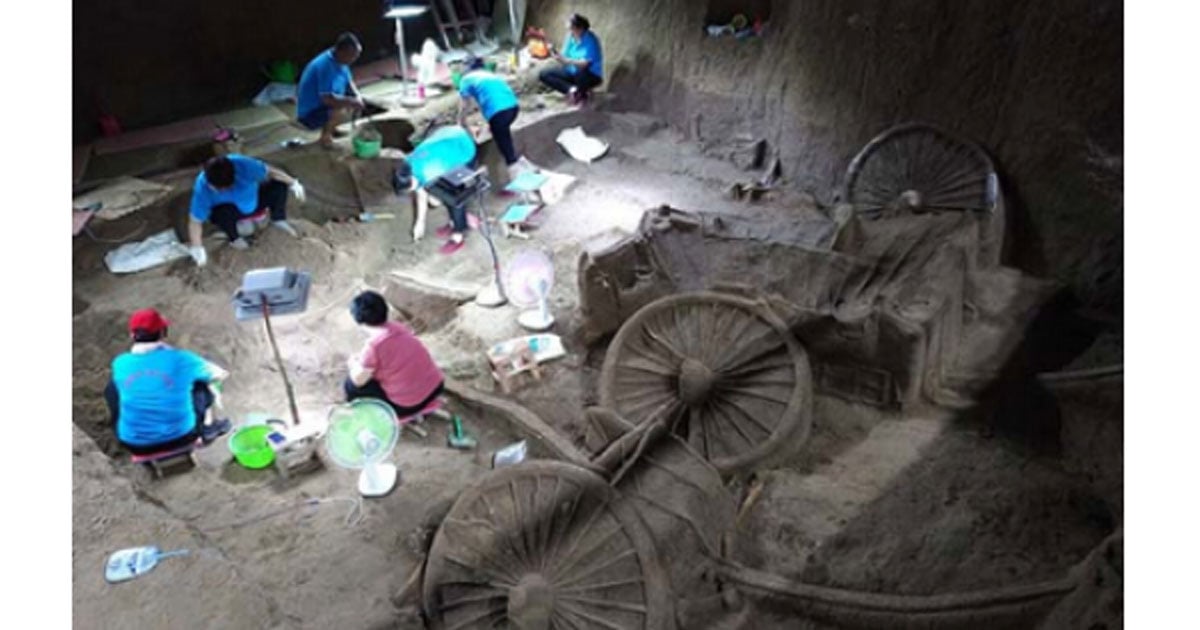2400-year-old Chariot Dubbed an Ancient Limousine Discovered in Central China
Archaeologists have recently discovered a "limousine" that once belonged to the Lord of Zheng State. The unusual find dates back 2,400 years and was uncovered by a team of archaeologists which has been excavating for the past five months in Xinzheng City, central China's Henan Province.
Fancy “Limousine” Belonged to a Wealthy Nobleman
The fancy “limousine” was uncovered in a funerary pit in tomb of Lords of Zheng State, a vassal state during the Spring and Autumn Period (770-476 BC) and the Warring States Period (475-221 BC). The vast, profligate chariot, which according to China Daily reports is about 2.56 meters long and 1.66 meters wide, was equipped with rain and sun protection on the top and adorned with bronze and bone ornaments. With a clearly visible outline after excavation and cleaning, each wheel of the massive chariot has twenty-six spokes in, a fact that shows the owner's rich and aristocratic background. "The chariot is the largest and most extravagant one so far in the excavation site," Ma Juncai, leader of an archaeological team with Henan Provincial Institute of Cultural Heritage and Archaeology, told China Daily. And added, "The 'limousine' was comfortable and spacious. People could stand, sit or lie in it. It was the best public vehicle used by lords of Zheng State and their wives.”
- 2,300 Years and Still Shining: Archaeologists Unearth Brilliantly Preserved Chinese Sword
- The Lasting Legacy of Wiseman Confucius
- Chinese man finds old sword in ground, uses it as kitchen knife
![The luxury chariot was uncovered in Zheng State No. 3 pit in Xinzheng city, Central China's Henan province, on July 12. [Photo credit: VCG]](https://www.ancient-origins.net/sites/default/files/styles/large/public/The-luxury-chariot_0.jpg?itok=zZdLbBlO)
The luxury chariot was uncovered in Zheng State No. 3 pit in Xinzheng city, Central China's Henan province, on July 12. [Photo credit: VCG]
Not the First Impressive Chariot Excavated in China
This, however, is not the first time (and most likely won’t be the last) an impressive chariot is uncovered in China. As reported in a previous Ancient Origins article, archaeologists excavated in 2015 a burial from the Zhou Dynasty era that included in the grave an elaborate chariot. The impressive chariot was decorated with a dragon, brass bells and jade pieces, a chariot of inferior quality, remains of two horses with bronze helmets, pottery shards and stone implements. Archaeologists speculated that the soldier buried there probably took part in the battle of Muye and was possibly honored by his people as evidenced by the richness of the grave goods. The Archaeology News Network blog described the grave and its artifacts in great detail, mentioning amongst other things that,
“The two chariots were end to end, with the horses’ heads facing east. Chariot Number One … is of high quality with picturesque decoration. The chariot and the two horses [are] in relatively good condition. The chariot body is covered in reddish brown lacquer, with components such as the wooden block under the chariot and the side planks decorated with a red lacquered deformed dragon design. Furthermore, the yoke on the shaft crossbar is decorated with bronze tinkling bells. Both ends of the axel are decorated with bronze caps. On the front of the chariot and on either side of the body are almost square-shaped jade pieces. Apart from an abundance of decoration on the faces of the horses, along with many leather or linen horse abdomen fittings decorated with bronze, there were also two bronze helmets on their heads.”
- An honored Zhou Dynasty warrior, buried with a chariot and horses, has been unearthed in China
- Shui-mu Niang-niang: The Old Mother of the Waters Who Submerged an Ancient City
- Two-face bronze head unearthed in central China

The chariot discovered in 2015 with horse skeletons at left in the grave (Photo by Chinese Archaeology)
More Horses than Chariots in the Pit
Returning to 2017 and the most recent discovery, the team of archaeologists excavating in Xinzheng City, also discovered four chariots in a pit, which all headed west, directing to their founding capital as Ma explained that the state was founded in Huaxian County of northwest China's Shaanxi Province. The archaeologists who are now cleaning the third chariot, stated that its left wheel was damaged by tomb robbers, while Ma added, "There are more horses than chariots in the pit. The excavation is expected to complete in September. The new discovery can provide significant evidence for the study on science and technology, production and civilization of the Spring and Autumn Period and the Warring States Period," China Daily reports.
Ultimately, the team of archaeologists and researchers stated that excavation of Zheng State tombs and the surrounding 20 hectares of land has already uncovered eighteen horse and chariot pits and more than 3,000 tombs.
Top image: Archaeologists excavate the Zheng State No. 3 pit in Xinzheng city, Central China's Henan province, on July 12. (Image credit: VCG)



















